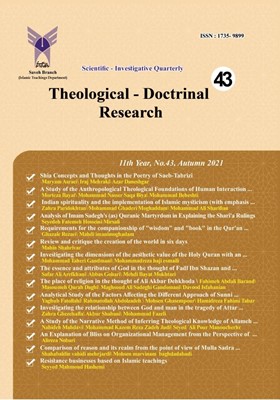Investigating the relationship between God and man in the tragedy of Attar and Haft Aurang Jami
Subject Areas : عرفان و معنویت دینیزهرا قزلسفلی 1 , Akbar Shabani 2 , Mohammad Fazeli 3
1 -
2 -
3 -
Keywords:
Abstract :
Man, God and their relationship with each other is one of the most fundamental topics in mystical literature. Mystical poets, as the possessors of the gentle and sensitive divine spirit, have included the relationship between God and man in the form of grace and pleasantness, which has become one of the deepest phrases of their works. This study has examined the relationship between God and man in a library and in a comparative way in the tragedy of Attar Neyshabouri and Divan Jami. The purpose of this study is to investigate the relationship between God and man based on the basic human principles of help, guidance and love, which shows that the relationship between God and man is one of the important concerns of these two mystics and they offer different ways and factors to achieve it. In; The most important results This research includes the fact that the works of Attar and Jami are full of the relationship between God and man, and this relationship is sometimes quoted from the language of the poet and sometimes from the language of fictional characters. The recklessness, courage and intimacy that exist in the poems of these two have given a special depth to their verses that give the reader a feeling of tenderness and the peak of servitude, while the loving relationship of God has been the highest type of relationship.
بوبر، مارتین (1398)، من و تو، ترجمه ابو تراب سهراب، تهران: فرزان روز.
تیواری، کدارنات، (1381)، دینشناسی تطبیقی، ترجمه مرضیه شنکایی، ویرایش علمی بهزاد سالکی، چاپ اول، تهران: سازمان مطالعه و تدوین کتب علوم انسانی.
جامی، عبدالرحمن (1366). مثنوی هفتاورنگ، تصحیح مدرس گیلانی، تهران: سعدی، چاپ دوم.
جیمز، ویلیام (1387). دین و روان، ترجمه مهدی قائینی. قم: دارالفکر
خرمشاهی، بهاءالدین (1377). حافظنامه، تهران: انتشارات سروش، چاپ چهارم.
الراغب الاصفهانی، أبی القاسم الحسین بن محمد.(1404 ه.ق). المفردات فی غریب القرآن. دفتر نشر الکتاب.
سروش، عبدالکریم، (1381)، سنت و سکولاریزم، تهران: صراط.
عطار نیشابوری، فریدالدین محمد (1386). مصیبتنامه، مقدمه، تصحیح و تعلیقات دکتر محمدرضا شفیعی کدکنی. تهران: سخن، ج 2، چاپ سوم
عطار نیشابوری، فریدالدین محمد، (1388)، مصیبتنامه، مقدمه، تصحیح و تعلیقات محمدرضا شفیعی کدکنی، چاپ پنجم، تهران: سخن.
صارمی، سهیلا (1373)، مصطلحات عرفانی و مفاهیم برجسته در زبان عطّار، چاپ اوّل، تهران: پژوهشگاه علوم انسانی و مطالعات فرهنگی.
کوربت، لیونل (1393)، رواندرمانی مذهبی، مترجمین سیامک خدا رحیمی و دیگران، چاپ اول، تهران: آراد کتاب.
محمدی ریشهری، محمد (1375)، مبانی خداشناسی، چاپ اول، قم: دارالحدیث.
مدی، ارژنگ (1372). عشق در ادب فارسی از آغاز تا قرن ششم، چاپ دوم، قم: موسسه التحقیقات و البحوث الثقافیه.
مطهری، مرتضی (1351)، هدف زندگی، چاپ اول؛ قم: دفتر انتشارات اسلامی.
مطهری، مرتضی. (1361). گفتارهای معنوی. تهران: صدرا.
مولوی، جلالالدین محمد بلخی (1379)، مثنوی معنوی، به سعی و اهتمام رین ولد نیکلسون، تهران: ثالث و همای.
یونگ، کارل گوستاو (1370)، روانشناسی و دین، ترجمۀ دکتر محمدحسین سروری؛ تهران: سخن.
ایزوتسو، توشیهوکو (1348)، ارتباط غیرزبانی میان خدا و انسان، معارف اسلامی، شماره 8، صص 62-51.
پژوهنده، لیلا (1391). رابطۀ خدا و انسان در ادبیات خداشناسی و عرفانی با تأکید بر آثار مولوی، نشریه ادب پژوهی، شمارۀ 22، صص 124-97.
زرگران، ایمان (1398). خدای وحدت وجودی و تصاویر برآمده از آن در آثار منظوم عطار، مجلهی علمی شعر پژوهی، دانشگاه شیراز، شماره سوم، سال یازدهم، صفحات 42-19.
علم مهرجردی، نسرین (1391). رابطه خدا با انسان؛ تمثل، تجسد یا تجلی؟، دوره 9، شماره 28، صص 30-5.
غزازنی، الهام (1396). رابطه بین انسان و خدا از دید مولانا، اسفار، سال سوم، شماره 6، صص 132-111.
صادقی، منصوره السادات (1393). نقش ابعاد اصلی شخصیت در نوع ارتباط با خدا، دو فصلنامه علمی پژوهشی مطالعات اسلام و روانشناسی، شماره 15، صص 126-103.
لطفی، سید مهدی (1391)، الگوهای ارتباط وحیانی، مجله علمی پژوهشی الهیات تطبیقی، شماره 7، صص 100-79.
Froese, P. & Bader, C. D. (2007). God in America: Why theology is not simply the concern of philosophers. Journal for the Scientific Study of Religion, 46, 465–481.
Kapogiannis, D. Barbey A. K. Su, M. Krueger, F. & Grafman, J. (2009). Neuroanatomical variability of religiosity. PLoS ONE, 4(9), e7180. doi:10.1371/journal.pone.0007180.
Kapogiannis, D. Barbey, A. K. Su, M. Zamboni, G. Krueger, F. & Grafman, J. (2009). Cognitive and neural
foundations of religious belief. Proceedings of the National Academy of Sciences of the U.S.A. 106, 4876–4881.
Kay, A. C. Gaucher, D. McGregor, I. & Nash, K. (2010). Religious belief as compensatory control. Personality and Social Psychology Review, 14, 37–48.
Krause, N. (2010).God-mediated control and change in self-related health. The International Journal for the Psychology
of Religion, 20, 267–287.
Popp, C. A. Luborsky, L. Andrusyna, T. P. Cotsonis, G. & Seligman, D. (2002). Relationships between God and people in the Bible: A core conflictual relationship theme study of the Pentateuch/Torah. Psychiatry: Interpersonal and Biological Processes, 65, 179–196.
WEINGARTEN, Carol P. et al. Relationships between God and people: an interpersonal study of scriptures. International Journal for the Psychology of Religion, 2014, 24.2: 133-150.


